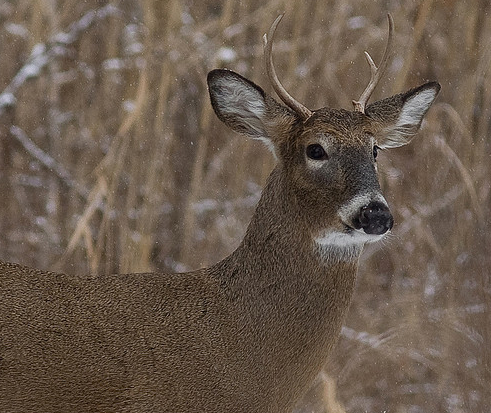What's Michigan deer season for? Trophies or venison?
Each year, in late summer, the state Department of Natural Resources issues its "Hunting and Trapping Digest," a 5-by-8 1/2-inch booklet of 60 pages or so, filled with the rules and regulations hunters must follow to legally take game in Michigan.
Sixty pages? Well, hunting and trapping laws are a lot more complicated than you might think - more complicated, some would say, than they need to be. They vary from county to county, and change from year to year. To the credit of those who write the guide, they make it a point each year to highlight the new rules for that year. The 2013 edition, for example, features a box on the front of the digest labeled “MAJOR CHANGES.”
There are three such changes listed. Buried under two insignificant notes about cosmetic tweaks to the rules, you'll find this odious line: “New Antler Restrictions see pg. 32.” Whether the positioning is a deliberate attempt to downplay No. 3, I cannot say. In any case, it will hardly go unnoticed. Those of us who hunt the areas affected – and who pay attention to DNR maneuvering – knew the change was coming. The debate and deliberations were public record, although this was a classic case of the squeaky wheels getting all the grease.
Hunters who tuned out over the summer will hear about the new antler restrictions soon enough, presumably before they realize that the buck they just tagged – the kind of buck that has been legal in Michigan for at least 92 years – now can land them in jail and cost them up to $2,000 in fines and restitution.
In 1921 the DNR defined an antlered deer as one having at least one antler that measured three inches or more. (It's unclear whether there were any restrictions at all before then.) That's the way it's been since 1921. In that time many hunters – beginners and veterans – have been happy and proud to drag a “spikehorn” (one antler on each side), or a “forkhorn” ( two points on each side) back to camp. These people would be violators under the new laws.
If you turn to page 32 of the digest, and decipher the table there, you'll find that in many counties north of Clare, a legal buck must now have at least three antler points on one side. This includes Wexford County, where, at least in some sections, deer are scarce, bucks are scarcer, and so-called trophy bucks are virtually non-existent. I know because my extended family's 80-acre deer camp, established near the town of Manton in 1968, though rich in camaraderie, is poor in venison production. Every year on the opening day of the firearms season a dozen or more experienced, skilled hunters fan out on the property and the surrounding state land. In a typical three-day hunt, we kill two or three deer – a couple of does, maybe, and a forkhorn.
The new antler restrictions are the result of a movement among some hunters – and apparently inside the state Natural Resources Commission – called Quality Deer Management. Translation: "We want to kill deer with bigger antlers." The theory is that if hunters are forced, by law, to refrain from shooting spikehorns and forkhorns, those deer will live to grow bigger antlers. That's largely true; age is a key factor in determining antler size. But it's by no means the only factor. Nutrrition and genetics are also important. I have killed several eight-pointers – and one nine-pointer – on my 12-acre homestead in Ingham County that were determined by the wildlife experts at Rose Lake to be 1 1/2 years old. At our camp in Wexford, some 1 1/2-year-old bucks barely manage the three-inch minimum.
But the larger point is that the big-antler obsession is not necessarily universal. Who decided that “quality” automatically means bodacious headgear? Antlers don't improve the taste of the venison. And they don't automatically pose a bigger challenge. Killing a spikehorn in Wexford County is no less challenging than killing an eight-pointer in southern Michigan.
For reasons that aren't clear to me, the QDM people keep insisting it's not about “trophy hunting,” but that's exactly what it's about. What else could it be? And I'm not saying there's anything wrong with that; if a hunter wants to hold his fire until an eight-pointer comes along, more power to him. But that doesn't give him the right to change the rules.
QDM is, quite simply, a case of some hunters imposing their proclivities on all hunters. But there's more to hunting whitetails in Michigan than big antlers. Given a choice between a hunter who idolizes big antlers and one who prizes venison, I'll take the meat hunter any day.
See what new members are saying about why they donated to Bridge Michigan:
- “In order for this information to be accurate and unbiased it must be underwritten by its readers, not by special interests.” - Larry S.
- “Not many other media sources report on the topics Bridge does.” - Susan B.
- “Your journalism is outstanding and rare these days.” - Mark S.
If you want to ensure the future of nonpartisan, nonprofit Michigan journalism, please become a member today. You, too, will be asked why you donated and maybe we'll feature your quote next time!


 THROW HIM BACK: Under new DNR hunting regulations, this forkhorn buck would be illegal in some Michigan counties this season. (Photo by Flickr user Steve Burt; used under Creative Commons license)
THROW HIM BACK: Under new DNR hunting regulations, this forkhorn buck would be illegal in some Michigan counties this season. (Photo by Flickr user Steve Burt; used under Creative Commons license)